What's New
Displaying results 3881 - 3890 of 4052
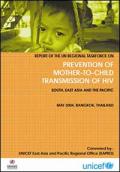
Resource | Publications,
The United Nations Regional Taskforce on Prevention of Mother-to-Child Transmission of HIV met from 11-13 May 2004 in Bangkok, involving countries from East and South Asia and the Pacific.
The meeting aimed to strengthen communication and cooperation among those working on PMTCT in Asia and the Pacific through sharing country experiences and technical updates from global experts. Specific attention was also given to issues related to increasing access to
antiretroviral treatment.
On the future of the Regional PMTCT Taskforce it was agreed to continue the representation of the East Asia, South Asia and Pacific regions, to meet approximately three times every two years and to ensure that other UN agencies and NGOs are involved in planning and attending meetings, as well as representatives of women affected by and living with HIV/AIDS.
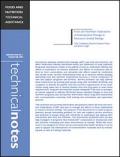
Resource | Publications,
Interactions between antiretroviral therapy (ART) and food and nutrition can affect medication efficacy, nutritional status, and adherence to drug regimens. Drug-food interactions consist of the effects of food on medication efficacy, the effects of medication on nutrient utilization, the effects of medication side effects on food consumption, and unhealthy side effects caused by medication and certain foods. As ART interventions scale up in resource limited settings, addressing food and nutrition implications becomes a critical component of care and support programs and services.
This technical note summarizes the types of ARVs commonly used; offers a framework for understanding drug-food interactions; describes key issues and steps for managing ARV-food interactions; identifies areas where knowledge gaps exist; and lays out the specific food and nutrition implications of ARVs commonly used in resource limited settings. This information aims to support program design and service provision.
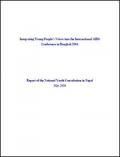
Resource | Publications,
Nepal's first cases of HIV/AIDS were reported in 1988. At the end of 2003 it was estimated that 62,000 people were living with HIV/AIDS. The epidemic assessments reveal a low prevalence among the general population and that so far HIV/AIDS is still concentrated among certain groups like Female Sex Workers (FSW), Intravenous Drug Users (IDUs) and labor migrants. However as shown by global experience and specific studies conducted in Nepal the young people remain highly vulnerable to the disease.
In an effort to strengthen its national response to HIV/AIDS, Nepal established a National Center for AIDS and STD Control (NCASC) and a National AIDS Council that in October 2002 endorsed the National HIV/AIDS strategy. Prevention of new infections among young people is one of the 5 key priority areas identified in the strategy and therefore young people shall receive greater attention in future HIV/AIDS-related programming.
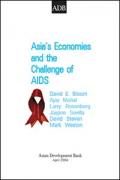
Resource | Publications,
Over the last few decades, the eyes of much of the world have turned toward Asia and the Pacific. In many countries in the region, economic growth has taken off, poverty has decreased, and people are better educated and healthier than ever before. Not all of Asia has participated equally in these wide-ranging social and economic changes, but much of the region is moving ahead.
Despite this picture of promise, however, HIV/AIDS poses a threat that cannot be ignored. In Asia and the Pacific, as in the rest of the world, the number of those infected with HIV is increasing rapidly, as is the number of people in whom the infection has progressed to the disease of AIDS.
Treating AIDS is expensive, but not treating it—allowing it to spread even faster – may be even more so. In this way, too, the countries of Asia face an enormous challenge.
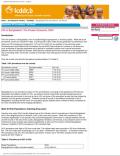
Resource | Publications,
The HIV epidemic in Bangladesh, from an epidemiological perspective, is evolving rapidly. While still a low prevalence country for overall HIV rates, a small pocket of IDU under second generation surveillance has shown an HIV prevalence increased from 1.4% to 4% to 8.9% (in one locality) in the past three years. Simultaneously recent Behavioral Surveillance Survey (BSS) data indicate an increase in risk behaviors such as sharing of injecting equipment and a decline in consistent condom use in sexual encounters between IDUs and female sex workers. BSS data also indicate that the IDU population is well integrated into the surrounding urban community, socially and sexually, thus raising grave concern about the spread of HIV infection.
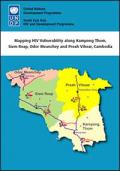
Resource | Publications,
This report is based on a mapping of HIV vulnerability along selected sections of secondary and tertiary feeder roads along National Road Number Six. This mapping was done as part of the preparatory phase of the World Bank Provincial and Rural Infrastructure Project (PRIP). This project aims at reducing rural poverty through economic and social development, thus facilitating the reintegration of the four target provinces into mainstream national development. The development objective of the PRIP is to provide sustainable and safe access to markets and essential services for people located in rural areas of Kampong Thom, Siem Reap, Odor Meanchey and Preah Vihear.
The increasing prevalence of HIV takes away the benefits from rehabilitation and development of the road system. The ASEAN leaders recognized the importance of the Chiang Rai Recommendation, adopted in 1999, when they again reiterated the importance of regional cooperation in reducing HIV vulnerabilities related to population movement and development at the ASEAN summit in 2001.
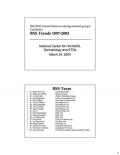
Resource | Presentations,
The BSS ‐ Purpose:
- Provide specific-year information on socio-demographic and risk behavior related to HIV/STDs
- Monitor sexual behavior of risk groups from year to year to determine trends in behavior change
- Provide baseline data for the three-year USAID funded provinces
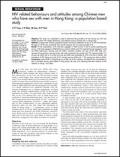
Resource | Publications,
This study was conducted in order to determine the prevalence of men having sex with men (MSM) and their HIV related behaviours and attitudes among Chinese men in Hong Kong. Methods: A large scale, random, population based, anonymous telephone survey of 14 963 men between the ages of 18–60 was conducted. The overall response rate was approximately 57%.
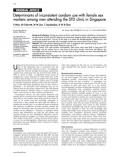
Resource | Publications,
Female sex workers and their male clients have been identified as risk groups for the transmission of STDs and HIV. Behavioural interventions targeting clients need to address inconsistent condom use among them. The aim of the study is to assess the sociodemographic, behavioural, and psychological factors associated with inconsistent condom use among clients of sex workers.
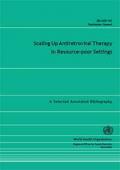
Resource | Publications,
This annotated bibliography is intended as a resource for policy makers, programme managers and other personnel working in HIV/AIDS control in developing countries. The aim of this bibliography is to provide representative examples of developing country’ experiences on the effectiveness and programmatic challenges for scaling up adult national antiretroviral treatment programmes.
Given that antiretroviral treatment in developing countries is recent, and research in the field is still emerging, the articles for which annotations are presented here not only include examples from original research, but also published viewpoints, research letters, correspondence, etc.





